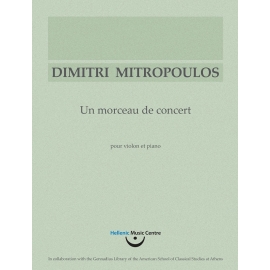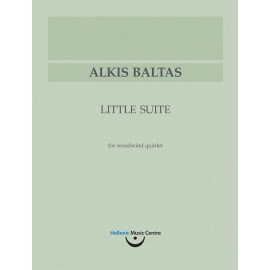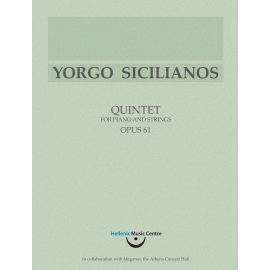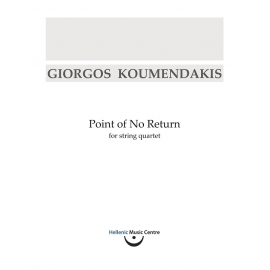No products
Product successfully added to your shopping cart
There are 0 items in your cart. There is 1 item in your cart.
 View larger
View larger
Kalafati: Quartet no. 2 in F minor, Op. 22
HMC 030
New
Vasily Kalafati (1869-1942)
Quartet no. 2 in F major, Op. 22 (1906-07)
for 2 violins, viola and violoncello
Set of parts
Published in collaboration with the Hellenic Music Research Lab of the Music Department of the Ionian University
Duration: 30’
ISMN: 979-0-801168-19-1
Pages: 112
Score editing: Louisa Tsougaraki
Corrections and score design: Yannis Samprovalakis
Music copying: Evelina Charkoftaki
More info
Vasily Kalafati: Two String Quartets in First Edition
Vasily Kalafati was born to a Greek merchant family in Yevpatoriya, Crimea, in 1869. Though well known to Russian-speaking musicologists, he is virtually unknown to the rest of the world. And yet, Vasily Kalafati was not only a student of Rimsky-Korsakov, but was himself a teacher of composition at the St Petersburg Conservatory, from 1901 to 1929 (from 1912 as a Professor of Composition), with Boris Asafyev, Heino Eller, Khristofor Kushnaryov, Vladimir Shcherbachyov, Igor Stravinsky, Anoushavan Ter-Gevondyan, and Maria Yudina numbering among his students. He was part of the Belyayev Circle, was published by Edition M. P. Belaieff (based in Liepzig), was one of the recipients of the Glinka Prize, set up by Belyayev in 1884, which brought with it a monetary award of 3000 roubles, as well as a recipient of the Belyayev Prize. In 1928, he received the second prize at the International Schubert Competition for his symphonic poem Légende, composed specifically for the occasion.1
Kalafati also published the dictionary Sputnik muzykanta [The Musician’s Companion, St Petersburg, 1911],2 and produced four-hand piano arrangements of Scriabin’s Second Symphony and various works by Lyadov.3 His Symphony in A minor (1899) was often performed at the Russian Symphony Concerts, and he regularly attended Belyayev’s famous ‘Friday evenings’. His last work, Zvezdy Kremlya [The Kremlin Stars], was composed in 1941, and was performed again in 2010, along with several others of his works, at the 19th International Arts Festival in St Petersburg, entitled ‘War and Peace’.4 Kalafati died of starvation during the siege of Leningrad, in 1942.
The archive of the composer is now housed in the library of the Hellenic Music Research Lab of the Ionian University’s Music Department. This volume presents, for the first time, critical editions of the String Quartet in G minor, Op. 15, and the String Quartet in F major, Op. 22.
The quartets were never published, but there are indications on the parts of Op. 22 that suggest it might have been performed, which leads us to suppose that it may have been composed for the Belyayev Circle’s ‘Musical Fridays’, albeit after Belyayev’s death. Judging from the rest of the composer’s archive, it is unusual for him to have neglected to date the manuscripts of these two quartets. According to the catalogue compiled by Kalafati’s son, Anatoli, however, both quartets were composed in 1906‒07.5
Both quartets are in four movements. Op. 15 is, in all respects, the more classical in style of the two—despite its various quirks and distinctly Russian elements—even to the extent of having the second movement in the traditional subdominant. Op. 22 has an unusual second movement as well, this time not in the subdominant, but in the submediant. Both quartets show a fondness for motoric, perpetuum mobile rhythms, and strong chromaticism, as well as for polyphony, canons, and imitation. Op. 15 is the more contrapuntal of the two pieces, with a stricter, more reserved and subtle style; Op. 22 is more chromatic, grander, and bolder in its musical gestures. The second movements are based on themes in the style of Russian folk-songs.6 The Scherzi in both quartets feature intensely lyrical episodes, though the structure of the Scherzo in Op. 15 is closer to a sonata form than to a scherzo and trio, complete with introduction, exposition, development and recapitulation (albeit a short one), whereas the bolder Op. 22 makes do with an ordinary ternary scherzo form. The first and last movements follow a sonata form structure.
The Manuscripts
For Op. 15 we have three sources at our disposal: an autograph full score, as well as one autograph set of parts, and a sketch of the second movement (Fuga a 4 voci). All are written on matching, Jurgenson of Moscow music notebooks, except for the sketch, which is written on one loose bifolio and a single sheet of Jurgenson paper. All survive in rather poor condition, although the parts, overall, are in better shape than the full score.
The sources for Op. 22 are two autograph full scores, and two autograph sets of parts.7 The notebooks have no factory name printed, and no watermark, so they are impossible to identify and offer no assistance in confirming the dating of the piece. Also, unlike Op. 15, the notebooks of the parts match with neither of the notebooks of the full scores.All of the notebooks of Op. 22 are also in very poor condition.
As mentioned earlier, neither quartet is dated, though on folio 1 recto of the second full scorethe composer’s address can be found, written in pencil: B. P. Kalafati / B. (Bol’shaya) Moskovskaya / d. 6, kv. 16. [V. P. Kalafati / B. (Great) Moskovskaya / h. (house) 6, f. (flat) 16.]. From the composer’s correspondence available in the archive, it appears that this is the address at which he lived from 1936 to the end of his life.8
Dating and Chronology
The works were always numbered by the composer himself, but, where for the published works the opus numbers follow a strict chronological order, for the unpublished works the numbering is chronologically inconsistent. For example, Op. 9, Trois Bagatelles [Three Bagatelles], was composed in 1905‒06 and was first published in 1907. Op. 10, Deux Préludes [Two Preludes], was again composed in 1906 and published in 1907. Op. 11, Quintet in G major, was composed in 1907, saw its first performance on 23 November 1908 and was published in 1909. Yet, according to Anatoli Kalafati, both Quartet in G minor (Op. 15) and Quartet in F major (Op. 22) were composed in 1906‒07.
For Op. 15, the Jurgenson notebooks, on which both the full score and the parts are written, firmly date the piece to before 1917, for in 1918 the P. Jurgenson company was nationalised and renamed Muzgiz. For Op. 22, we cannot rely on the notebooks to confirm Anatoli Kalafati’s dating, but it must be said that the 1906‒07 date seems plausible. In the same period, Kalafati also composed a Sextet, dated 18 February 1906, while the Quintet in G major (Op. 11), composed in 1907, shares stylistic similarities with Op. 22. Following this, it appears that Kalafati did not compose any more chamber music until 1929, when he begun composition of the Piano Trio in C minor (Op. 23). There is sadly no other documentary information we can draw upon to confirm the 1906‒07 composition date, for either quartet. With the 1906‒07 date in mind, therefore, the inconsistent opus numbers still need to be accounted for.
The most likely explanation is that the composer did not number his works at the time of composition, but later, perhaps after some final revisions or reworking. This explanation is also supported by the autograph sources.
LOUISA TSOUGARAKI
1 Stanimira Dermejieva, Vasilis P. Kalafatis (1869‒1942): E Zoe ke to Ergo Enos Lesmonemenou Synthete ke Mousikopedagogou tes Rosias [Vasily P. Kalafati (1869‒1942): The Life and Work of a Forgotten Composer and Music Teacher of Russia], Ph.D. dissertation (Corfu: Ionian University, Department of Music Studies, Hellenic Music Research Lab, 2011), 199‒200 [available at https://www.didaktorika.gr/eadd/handle/10442/30138 (accessed: 13 September 2022)].
2 Dermejieva, ibid., 131.
3 Mikhail Mishchenko, ‘Kalafati, Vasily Pavlovich’, in Grove Music Online, ed. Deane Root, http://www.oxfordmusiconline.com (accessed: 14 September 2022).
4 Saint Petersburg Contemporary Music Centre website, http://www.remusik.org/en/from_the_avant_garde_to_the_ present_day_2010/ (accessed: 3 January 2011); Dermejieva, op. cit., 240.
5 Anatoli’s catalogue is part of the Kalafati Archive.
6 Identified by Stanimira Dermejieva.
7 At the time of writing, the manuscripts had not yet been incorporated into the Hellenic Music Research Lab library’s system, hence there are no manuscript numbers available.
8 Personal communication with Stanimira Dermejieva.
14 other products in the same category:
Download




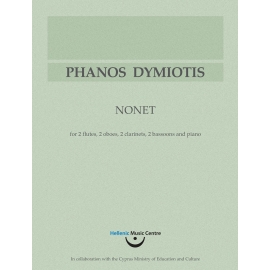



![Logothetis: Permutationen [Permutations]](https://hellenicmusiccentre.com/img/p/4/3/43-tm_home_default.jpg)
